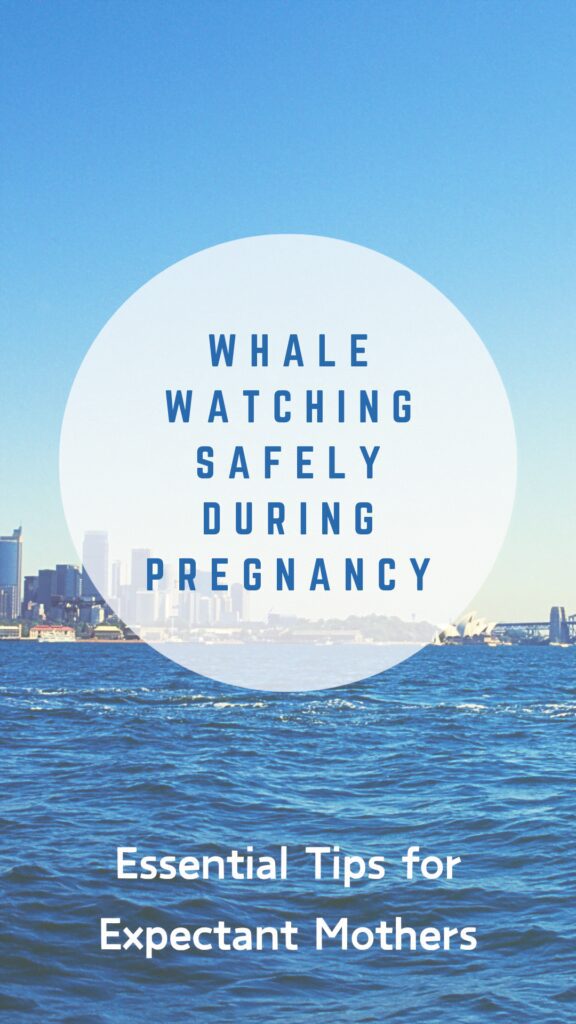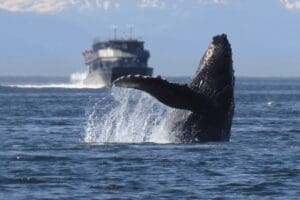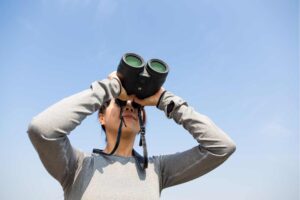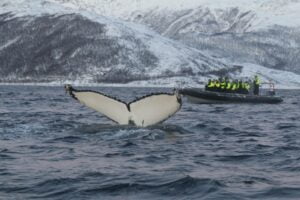Whale Watching During Pregnancy: Safety Tips and Considerations
Whale watching is not just an activity; it’s an adventure into a world of awe-inspiring beauty and wonder. But what if you’re expecting a little one? Can this breathtaking experience still be a part of your journey? Absolutely!
This guide is dedicated to all the expectant mothers out there who dream of whale watching. We understand that safety is your top priority, and we’re here to ensure you enjoy this incredible experience with peace of mind. Join us as we dive into the world of whale watching during pregnancy, where safety meets the splendor of the seas.
Safety First: Whale Watching During Pregnancy
Embarking on a whale-watching adventure during pregnancy can be a thrilling and safe experience with the right precautions. Understanding the unique needs of expectant mothers is crucial for ensuring both your safety and enjoyment. Let’s explore the essential safety tips in detail.
Consult Your Doctor First
- Importance of Medical Advice: A consultation with your healthcare provider is essential before booking your trip. They can assess your specific situation, considering any pregnancy-related conditions or concerns.
- Personalized Recommendations: Your doctor can provide advice tailored to your stage of pregnancy and overall health, including any necessary precautions or limitations.
Choosing the Right Tour Operator
- Reputation and Experience: Select a tour operator with a strong safety record and experience in accommodating pregnant women. Check online reviews and ask for recommendations.
- Inquire About Facilities: Ensure the boat has accessible and comfortable seating restrooms and is equipped to handle emergencies.
Timing Your Trip
- Ideal Period: The second trimester is often the most comfortable time for pregnant women to engage in activities like whale watching, as the risk of morning sickness and fatigue is generally lower.
- Duration of the Trip: Consider shorter excursions to avoid fatigue. Ensure there are opportunities to rest and move around on the boat.
Hydration and Nutrition
- Staying Hydrated: Carry a reusable water bottle to keep hydrated throughout the trip. Dehydration can be more pronounced at sea.
- Healthy Snacks: Pack snacks like fruits, nuts, and granola bars. Opt for light, non-greasy foods to help prevent seasickness.
Dressing for Comfort and Safety
- Clothing: Wear loose, comfortable layers. Maternity wear that allows for easy movement is ideal.
- Footwear: Choose flat, non-slip shoes for stability on the boat.
- Weather Preparedness: Bring a waterproof jacket and extra layers for changing weather conditions.
Managing Sea Conditions
- Check Weather Forecasts: Before the trip, check the sea conditions. Calm waters are preferable for pregnant women.
- Positioning on the Boat: Stay seated during rough patches and choose a spot where the movement is minimal, usually near the center of the boat.
Listening to Your Body
- Recognizing Limits: Pay attention to how you feel. If you experience discomfort, inform the crew immediately.
- Rest Areas: Ensure there are areas on the boat where you can sit or lie down if needed.
Sun Protection
- Sunscreen: Use a high-SPF sunscreen to protect against sunburn.
- Protective Clothing: Consider wearing a hat and sunglasses. Light, long-sleeved shirts can provide additional sun protection.
Planning for Seasickness
- Medication: Discuss seasickness medication with your doctor. Options like ginger tablets or acupressure wristbands can be safe alternatives during pregnancy.
- Fresh Air: Staying on deck in the fresh air can help alleviate seasickness.
Emergency Preparedness
- Safety Briefing: Participate in the safety briefing before the trip starts. Know where life jackets are stored.
- Nearest Medical Facility: Be aware of the closest medical facility and have a plan in case of an emergency.
By meticulously planning and taking these detailed precautions, you can enjoy a memorable and safe whale-watching experience during your pregnancy. Remember, your comfort and safety are paramount, and with the right preparation, you can have a wonderful time connecting with nature’s gentle giants.
Download The Detailed Safety Checklist to avoid missing important actions and enjoy the whale-watching trip.
Special Considerations for Pregnant Women
When it comes to whale watching during pregnancy, there are specific considerations and precautions that need to be taken to ensure both the safety and comfort of the expectant mother. Understanding these nuances can make the difference between a delightful experience and an uncomfortable one.

Specific Precautions for Pregnant Women
- Avoiding Rough Waters:
- Understanding Sea Conditions: Knowing the sea conditions before embarking on a whale-watching trip is crucial. Rough waters can lead to uncomfortable or even risky situations for pregnant women.
- Choosing the Right Day: Opt for days when the forecast predicts calm seas. This ensures a smoother ride and reduces the risk of seasickness.
- Regular Consultations with a Doctor:
- Pre-Trip Check-Up: A check-up before planning your whale-watching trip is essential. Discuss any concerns and get advice tailored to your stage of pregnancy.
- Emergency Contact: Always have your doctor’s contact information handy if you need to consult them urgently during your trip.
Comfort Tips for Pregnant Women
- Best Times to Go Whale Watching:
- Consider Your Comfort: The second trimester is often the most comfortable time for pregnant women to engage in activities like whale watching. You’re likely past the morning sickness stage and not yet into the discomfort of the final trimester.
- Avoid Peak Hours: Consider going on a whale-watching trip during off-peak hours or weekdays to avoid large crowds and ensure a more relaxed experience.
- What to Wear for Maximum Comfort:
- Loose and Comfortable Clothing: Opt for breathable, loose-fitting clothing. Maternity wear that allows easy movement and accommodates temperature changes is ideal.
- Layering is Key: Weather at sea can be unpredictable. Dress in layers so you can easily adjust to changing conditions.
- Footwear: Choose flat, sturdy shoes with a good grip to prevent slips on the boat deck.
- Additional Comfort Measures:
- Seating Arrangements: Ensure you have access to comfortable seating. Some boats have specific areas with cushioned seating that can provide better support.
- Stay Hydrated: Keep a water bottle with you at all times. Staying hydrated is crucial, especially on the water.
- Snack Wisely: Bring along light snacks that are easy on the stomach, such as crackers, fruit, or yogurt.
It’s all about planning, understanding your needs, and ensuring those needs are met during the trip. With the right preparations, whale watching can be a wonderfully memorable experience during pregnancy.
Best Times and Places for Pregnant Women to Go Whale Watching
For expectant mothers looking to experience the wonder of whale watching, selecting the right time and location is key for a comfortable and safe journey. Here are some ideal seasons and locations, particularly focusing on destinations that are more accessible and comfortable for pregnant women in the United States.
Optimal Seasons for Whale Watching
- Mild Weather Considerations:
- Spring and Early Fall: These seasons typically offer more temperate weather, ideal for sea comfort. The milder conditions also correspond with lower chances of rough waters, making for a smoother sailing experience.
- Whale Migration Patterns:
- Align with Migration Seasons: Depending on the location, different times of the year will offer better opportunities to see whales. For example, grey whales are often spotted off the West Coast during their migration in the spring and fall.
Recommended Locations within the United States
- Monterey Bay, California:
- Protected Waters: Known for its sheltered bay, Monterey offers calmer waters, which is preferable for pregnant women.
- Rich Marine Life: The area is famous for its diverse marine life, including humpback whales, blue whales, and orcas, depending on the season.
- San Juan Islands, Washington:
- Serene Environment: The San Juan Islands provide a tranquil setting with protected waters, ideal for gentle whale watching.
- Variety of Whales: The waters around these islands are home to orcas, minke whales, and gray whales at different times of the year.
- Cape Cod, Massachusetts:
- East Coast Gem: For those on the East Coast, Cape Cod offers a fantastic whale-watching experience with relatively calm waters during the right seasons.
- Humpback and Minke Whales: The area is particularly known for sightings of humpback whales and minke whales in the summer months.
Conclusion
As we draw our guide to a close, let’s take a moment to reflect on the sheer beauty and thrill that whale watching offers. This unique experience brings you face-to-face with some of the most majestic creatures on our planet in their natural, awe-inspiring habitat. The gentle giants of the sea, with their serene grace and powerful presence, offer a spectacle that is both humbling and exhilarating.
For expectant mothers, connecting with these magnificent animals can add an extra layer of wonder and joy to the pregnancy journey. It’s a chance to experience the vastness and beauty of nature while awaiting the arrival of your own little one. The calmness of the ocean, the fresh sea air, and the rhythmic dance of the whales create a symphony of natural serenity that can be deeply moving and soothing.
Whale Adoption Project – Symbolically Adopt A Whale
Additional Resources:







